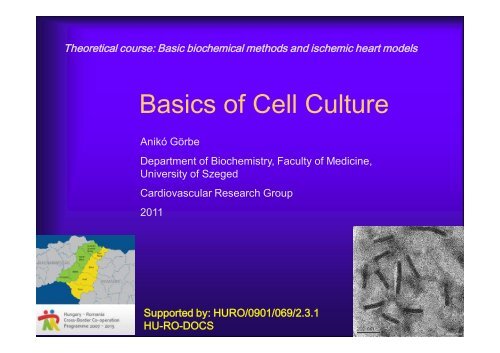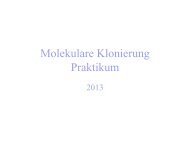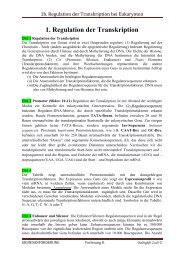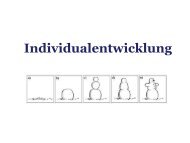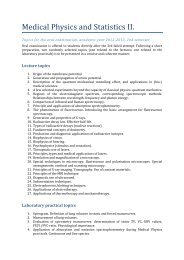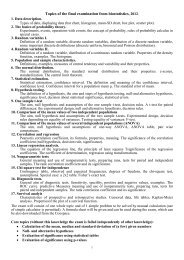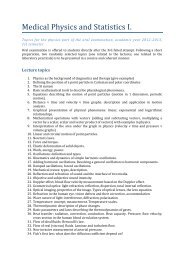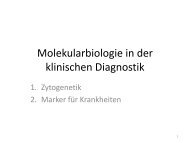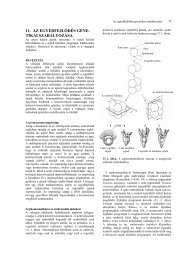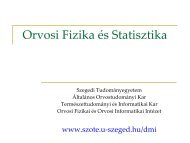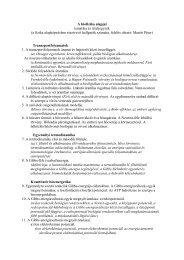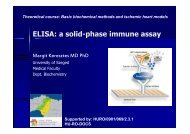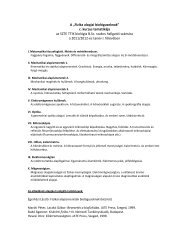Create successful ePaper yourself
Turn your PDF publications into a flip-book with our unique Google optimized e-Paper software.
Theoretical course: Basic biochemical methods and ischemic heart models<strong>Basics</strong> <strong>of</strong> <strong>Cell</strong> <strong>Culture</strong>Anikó GörbeDepartment <strong>of</strong> Biochemistry, Faculty <strong>of</strong> Medicine,University <strong>of</strong> SzegedCardiovascular Research Group2011Supported by: HURO/0901/069/2.3.1HU-RO-DOCS
Introduction• <strong>Cell</strong> culture is the process by whichprokaryotic, eukaryotic or plant cells aregrown under controlled conditions• In practice it refers to the culturing <strong>of</strong> cellsderived from animal cells.• <strong>Cell</strong> culture was first successfully undertakenby Ross Harrison in 1907• Roux in 1885 for the first time maintainedembryonic chick cells in a cell culture
Historical events in the development<strong>of</strong> cell culture• 1878: Claude Bernard proposed that physiological systems <strong>of</strong>an organism can be maintained in a living system after thedeath <strong>of</strong> an organism.• 1885: Roux maintained embryonic chick cells in a saline culture.• 1897: Loeb demonstrated the survival <strong>of</strong> cells isolated fromblood and connective tissue in serum• and plasma.• 1903: Jolly observed cell division <strong>of</strong> salamander leucocytes invitro.• 1907: Harrison cultivated frog nerve cells in a lymph clot held bythe 'hanging drop' method and observed the growth <strong>of</strong> nervefibers in vitro for several weeks. He was considered by some asthe father <strong>of</strong> cell culture.• 1910: Burrows succeeded in long term cultivation <strong>of</strong> chickenembryo cell in plasma clots. He made detailed observation <strong>of</strong>mitosis.
Continued...• 1911: Lewis and Lewis made the first liquid mediaconsisted <strong>of</strong> sea water, serum, embryo extract, saltsand peptones. They observed limited monolayergrowth.• 1913: Carrel introduced strict aseptic techniques sothat cells could be cultured for long periods.• 1916: Rous and Jones introduced proteolytic enzymetrypsin for the subculture <strong>of</strong> adherent cells.• 1923: Carrel and Baker developed 'Carrel' or T-flaskas the first specifically designed cell culture vessel.They employed microscopic evaluation <strong>of</strong> cells inculture.• 1927: Carrel and Rivera produced the first viralvaccine - Vaccinia.• 1933: Gey developed the roller tube technique
Continued...• 1965: Harris and Watkins were able to fuse human and mousecells by the use <strong>of</strong> a virus.• 1975: Kohler and Milstein produced the first hybridoma capable<strong>of</strong> secreting a monoclonal antibody.• 1978: Sato established the basis for the development <strong>of</strong> serumfreemedia from cocktails <strong>of</strong> hormones and growth factors.• 1982: Human insulin became the first recombinant protein to belicensed as a therapeutic agent.• 1985: Human growth hormone produced from recombinantbacteria was accepted for therapeutic use.• 1986: Lymphoblastoid γIFN licensed.• 1987: Tissue-type plasminogen activator (tPA) fromrecombinant animal cells became commercially available.• 1989: Recombinant erythropoietin in trial.• 1990: Recombinant products in clinical trial (HBsAG, factor VIII,HIVgp120, CD4, GM-CSF, EGF, mAbs, IL-2).
Major development’s in cellculture technology• First development was the use <strong>of</strong>antibiotics which inhibits the growth <strong>of</strong>contaminants.• Second was the use <strong>of</strong> trypsin toremove adherent cells to subculturefurther from the culture vessel• Third was the use <strong>of</strong> chemically definedculture medium.
Why is cell culture used for?Areas where cell culture technology iscurrently playing a major role.• Model systems forStudying basic cell biology, interactions between diseasecausing agents and cells, effects <strong>of</strong> drugs on cells, process andtriggering <strong>of</strong> aging & nutritional studies• Toxicity testingStudy the effects <strong>of</strong> new drugs• Cancer researchStudy the function <strong>of</strong> various chemicals, virus &radiation to convert normal cultured cells to cancerous cells
Why is cell culture used for?• VirologyCultivation <strong>of</strong> virus for vaccine production,also used to study there infectious cycle.• Genetic EngineeringscaleProduction <strong>of</strong> commercial proteins, largeproduction <strong>of</strong> viruses for use in vaccineproduction e.g. polio, rabies, chicken pox,hepatitis B & measles• Gene therapy<strong>Cell</strong>s having a functional gene can bereplaced to cells which are having non-functionalgene
Tissue culture• In vitro cultivation <strong>of</strong> organs, tissues & cells at definedtemperature using an incubator & supplemented witha medium containing cell nutrients & growth factors iscollectively known as tissue culture• Different types <strong>of</strong> cell grown in culture includesconnective tissue elements such as fibroblasts,skeletal tissue, cardiac, epithelial tissue (liver, breast,skin, kidney) and many different types <strong>of</strong> tumor cells.
Primary culture• <strong>Cell</strong>s when surgically or enzymatically removed froman organism and placed in suitable cultureenvironment will attach and grow are called as primaryculture• Primary cells have a finite life span• Primary culture contains a very heterogeneouspopulation <strong>of</strong> cells• Sub culturing <strong>of</strong> primary cells leads to the generation<strong>of</strong> cell lines• <strong>Cell</strong> lines have limited life span, they passage severaltimes before they become senescent• <strong>Cell</strong>s such as macrophages and neurons do not dividein vitro so can be used as primary cultures• Lineage <strong>of</strong> cells originating from the primary culture iscalled a cell strain
Making a Primary <strong>Culture</strong>
Animal:PRIMARY CARDIOMYOCYTE CULTURE•newborn rats (Wistar)Heart isolation:•hearts were excised andcollected in sterile PBSDigestion:•after washing in fresh PBS, atria were removed and ventricules werecut into small pieces and put into the tripsin (0.25%) solution•digestion was proceed in 37 degree in the water bath for 25 minand the cell suspension was resuspended every 5 minutes using 5 mlpipettes
PRIMARY CARDIOMYOCYTE CULTUREWashing and cell collection:•centrifuge the cell suspension in 2000 rpm for 15 min•remove the supernatant and resuspend the cells in growing medium(DMEM + 10% fetal calf serum (FCS) + gentamicin) – high glucose andglutamine content in the mediumPreplating: fibroblast elimination•plate the cells into 6-well plates for 30 min•collect the supernatant (non-attached cells) into a Falcon tubePlating:•6-well plate we plate 5x10 5 cells/ well•keep them at 37 and 5% CO 2 and change the medium next day (24h)
animalNEONATALNewborn- cheap (limitedcell number can beachieved)ADULTAdult –expensive, butmore cellspreparation simple more complicatedsensitivity relatively easy to handle very sensitivelife time couple <strong>of</strong> days, max 2weeks (long termexperiments as well)max 2-3 days (onlyshort term experiments)contamination yes, fibroblasts not observedcoated surface not required exclusively laminincoated surface can beusedmedium DMEM Medium 199 +additional compidentification IH <strong>of</strong> cardiomyocytes microscopic morphologyadherent yes yes
2 days old neonatal cardiacmyocyte culture
1 day old adult cardiac myocyteculture
Adhesion• Majority Of <strong>Cell</strong>s Adhere On Plastic (Treated)Provided They Are Not Transformed• It Was Observed That <strong>Cell</strong>s Prefer –velyCharged Glass Surface• Plastic (polystyrene) Is Tissue <strong>Culture</strong>Treated• With High Energy Ionizing Radiation• Electric Ion Discharge• Adhesion Is Mediated By Surface ReceptorsAnd Matrix• Matrix Is Secreted By <strong>Cell</strong>s, Adheres To ChargedPlastic• Receptors Bind to Matrix
<strong>Cell</strong> Surface Adhesion MoleculesThree Major Classes• <strong>Cell</strong>-<strong>Cell</strong> Adhesion Molecules• CAMs (Ca 2+ Independent)• Cadherins (Ca 2+ Dependent)• Primarily Between Homologous <strong>Cell</strong>s• Signaling occurs• <strong>Cell</strong>-Substrate Molecules• Integrins• Bind to fibronectin, entactin, laminin, collagen• Bind the specific motif (RGD, arginine, glycine,aspratic)• Comprised <strong>of</strong> and unit
<strong>Cell</strong> Surface Adhesion Molecules• 3 rd Class Is Proteoglycans• Also Binds Matrix or Other Proteoglycans• Not Via RGD Motif• Low affinity Growth Factor Receptors• May Aid Binding To Higher Affinity Receptors• No Signaling Capacity
<strong>Cell</strong> Lines<strong>Cell</strong> Line• <strong>Cell</strong>s that have undergone a mutationand won’t undergo apoptosis after alimited number <strong>of</strong> passages. They willgrow indefinitely.Transformed/continous cell line• A cell line that has been transformed bya tumor inducing virus or chemical.Can cause tumors if injected intoanimal.Hybrid cell line (hybridoma)• Two cell types fused together withcharacteristics <strong>of</strong> each
Continous cell lines• Most cell lines grow for a limited number <strong>of</strong> generations afterwhich they ceases• <strong>Cell</strong> lines which either occur spontaneously or induced virally orchemically transformed into Continous cell linesCharacteristics <strong>of</strong> continous cell lines-smaller, more rounded, less adherent with a highernucleus /cytoplasm ratio-fast growth and have aneuploid chromosome number-reduced serum and anchorage dependence and grow more insuspension conditions-ability to grow upto higher cell density-different in phenotypes from donar tissue-stop expressing tissue specific genes
Types <strong>of</strong> cellsOn the basis <strong>of</strong> morphology (shape & appearance) oron their functional characteristics.They are divided into three groups:• Epithelial like-attached to a substrate and appearsflattened and polygonal in shape• Lymphoblast like- cells do not attach remain insuspension with a spherical shape• Fibroblast like- cells attached to an substrate appearselongated and bipolar
<strong>Culture</strong> media• Choice <strong>of</strong> media depends on the type <strong>of</strong> cell beingcultured• Commonly used Medium are GMEM, EMEM,DMEMetc.• Media is supplemented with antibiotics viz. penicillin,streptomycin etc.• Prepared media is filtered and incubated at 4 C
Culturing <strong>of</strong> cells• <strong>Cell</strong>s are cultured as anchorage dependent orindependent• <strong>Cell</strong> lines derived from normal tissues are consideredas anchorage-dependent grows only on a suitablesubstrate e.g. tissue cells• Suspension cells are anchorage-independent e.g.blood cells• Transformed cell lines either grows as monolayer oras suspension
Why sub culturing?• Once the available substrate surface iscovered by cells (a confluent culture) growthslows & ceases.• <strong>Cell</strong>s to be kept in healthy & in growing statehave to be sub-cultured or passaged• It’s the passage <strong>of</strong> cells when they reach to80-90% confluency in flask/dishes/plates• Enzyme such as trypsin, collagenase incombination with EDTA breaks the cellularglue that attached the cells to the surface
Passage <strong>of</strong> Adherent cells• <strong>Cell</strong>s which are anchorage dependent• <strong>Cell</strong>s are washed with PBS (free <strong>of</strong> ca & mg )solution.• Add enough trypsin/EDTA to cover the monolayer• Incubate the plate at 37 C for 1-2 mts• Tap the vessel from the sides to dislodge the cells• Add complete medium to dissociate and dislodge thecells• with the help <strong>of</strong> pipette which are remained to beadherent• Add complete medium depends on the subculture• requirement either to 75 cm or 175 cm flask
Suspension cells• Easier to passage as no need to detach them• As the suspension cells reach to confluency• Asceptically remove 1/3 rd <strong>of</strong> medium• Replaced with the same amount <strong>of</strong> pre-warmedmedium
Working with cryopreservedcells• Vial from liquid nitrogen is placed into 37 C waterbath, agitate vial continuously until medium is thawed• Centrifuge the vial for 10 mts at 1000 rpm at RT, wipetop <strong>of</strong> vial with 70% ethanol and discard thesupernatant• Resuspend the cell pellet in 1 ml <strong>of</strong> complete mediumwith 20% FBS and transfer to properly labeled cultureplate containing the appropriate amount <strong>of</strong> medium• Check the cultures after 24 hrs to ensure that theyare attached to the plate• Change medium as the colour changes, use 20%FBS until the cells are established
Freezing cells for storage• Remove the growth medium, wash the cells by PBSand remove the PBS by aspiration• Dislodge the cells by trypsin-versene• Dilute the cells with growth medium• Transfer the cell suspension to a 15 ml conical tube,centrifuge at 200g for 5 mts at RT and remove thegrowth medium by aspiration• Resuspend the cells in 1-2ml <strong>of</strong> freezing medium• Transfer the cells to cryovials, incubate the cryovialsat -80 C overnight• Next day transfer the cryovials to Liquid nitrogen
• How “covered” thegrowing surface appears• This is usually a guess• Optimal confluency formoving cells to a newdish is 70-80%• too low, cells will be in lagphase and won’tproliferate• Too high and cells mayundergo unfavorablechanges and will bedifficult to remove fromplate.Confluency
<strong>Cell</strong> toxicity• Cytotoxicity causes inhibition <strong>of</strong> cell growth• Observed effect on the morphological alteration in thecell layer or cell shape• Characteristics <strong>of</strong> abnormal morphology is the giantcells, multinucleated cells, a granular bumpyappearance, vacuoles in the cytoplasm or nucleus• Cytotoxicity is determined by substituting materialssuch as medium, serum, supplements flasks etc. at atime
Viability assay – DEAD CELLSTrypane blueexclusionPropidiumiodineBiologicalindicatorDetectionmethodMembraneintegrityColorimetricmicroscopyMembraneintegrityFluorescentFACSTime 2 h 30 minlimitation 24 groups max 10 6 cells/wellrequired + Imre
Viability assay – LIVING CELLS<strong>Cell</strong>-TiterGlo (ATP)<strong>Cell</strong> TiterBlueresazurin<strong>Cell</strong> Titer96 (MTS)MTTLDHBiologicalindicatorATPcontentReducingabilityReducingabilityReducingabilityMembrane integrityDetectionmethodbioluminescentcolorimet-ricFluorimetricorcolorimetriccolorimetricTime 10 min 1-4 h 1-4 h 4 h 10 minUVSensitivity(96 plate)limitation50 cells 390 cells 800 cells 800 cells 800 cellsLumireaderFluororeaderUVreader
<strong>Cell</strong> viability• <strong>Cell</strong> viability is determined by staining the cells withtrypan blue• As trypan blue dye is permeable to non-viable cells ordeath cells whereas it is impermeable to this dye• Stain the cells with trypan dye and load tohaemocytometer and calculate % <strong>of</strong> viable cells- % <strong>of</strong> viable cells= Nu. <strong>of</strong> unstained cells x 100total nu. <strong>of</strong> cells
Hemacytometer• Specialized chamberwith etched gridused to count thenumber <strong>of</strong> cells in asample.• use <strong>of</strong> trypan blueallows differentiationbetween living anddead cells
Using the Hemacytometer• Take thehemacytometer andcoverslip (carefully) anddry thoroughly with akimwipe.• Center coverslip onhemacytometer• Barely fill the grid underthe coverslip via thedivet with your cellsuspension.• Count cells in tensquares (5 on each side)by following diagram atstation.
Looking at the gridunder the phasecontrast microscope
How the cells will appear• Bright refractile “spheres”are living cells,• Blue cells about the samesize as the other cells aredead.• Keep a differential count<strong>of</strong> blue vs. clear forviability determination.• Sometimes there will beserum debris, and this willlook red or blue andstringy or gloppy--don’tcount it!These are blood cells,You will not have this many
Viability assay – PI fluorescence intensitydetermined by plate readerPropidium iodineCardiac myocytes* *www.cardiovasc.com
SIMULATED ISCHEMIA in HYPOXIC CHAMBER95% N 2 and 5% CO 2 gas
SIMULATEDISCHEMIA(Li et al 2004)CONTROL SOLUTIONMolecularweightmM For 1 L (g) For 100 ml(mg)NaCl 58,44 125 7,305 730KCl 74,56 5,4 0,402 40,2NaH 2 PO4.1 H 2 O 137,99 1,2 0,1655 16,6MgCl 2 (saturated95,23 0,5 126 ul 12,6 ulsolution)HEPES 238,3 20 4,766 476,6glucose 198,18 15 2,972 297,2taurine 125,1 5 0,6255 62,6CaCl 2 .2 H 2 O 174,02 1 0,174 17,4(Creatine P.Na 2 .6 H 2 O) 363,2 2,5 0,908 90,8creatine 131,14 2,5 0,328 32,79BSA 0,1% 100pH: set to 7,4 (pH 6 was after mixing components)MgCl 2 (saturated solution): 1 ml contains 0,3774 gHYPOXIC SOLUTIONMolecularweightmM For 1 L (g) For 100 ml(mg)NaCl 58,44 119 6,954 695,4KCl 74,56 5,4 0,402 40,2NaH 2 PO4.1 H 2 O 137,99 1,2 0,1655 16,6MgCl 2 (saturated95,23 0,5 126 ul 12,6 ulsolution)HEPES 238,3 5 1,1915 119,2MgSO 4 .7 H 2 O 246,48 1,3 0,320 32CaCl 2 .2 H 2 O 174,02 0,9 0,1566 15,7Na-lactate 112,1 20 2,242 224BSA 0,1% 100pH: set to 6,4 (pH 6,4 was after mixing components)MgCl 2 (saturated solution): 1 ml contains 0,3774 g
Contaminant’s <strong>of</strong> cell culture<strong>Cell</strong> culture contaminants <strong>of</strong> two types• Chemical-difficult to detect caused by endotoxins,plasticizers, metal ions or traces <strong>of</strong> disinfectants thatare invisible• Biological-cause visible effects on the culture theyare mycoplasma, yeast, bacteria or fungus or als<strong>of</strong>rom cross-contamination <strong>of</strong> cells from other cell lines
Effects <strong>of</strong> Biological Contamination’s• They competes for nutrients with host cells• Secreted acidic or alkaline by-productsceses the growth <strong>of</strong> the host cells• Degraded arginine & purine inhibits thesynthesis <strong>of</strong> histone and nucleic acid• They also produces H2O2 which is directlytoxic to cells
Detection <strong>of</strong> contaminants• In general indicators <strong>of</strong> contamination are turbid culture media,change in growth rates, abnormally high pH, poor attachment,multi-nucleated cells, graining cellular appearance,vacuolization, inclusion bodies and cell lysis• Yeast, bacteria & fungi usually shows visible effect on theculture (changes in medium turbidity or pH)• Mycoplasma detected by direct DNA staining with intercalatingfluorescent substances e.g. Hoechst 33258• Mycoplasma also detected by enzyme immunoassay byspecific antisera or monoclonal abs or by PCR amplification <strong>of</strong>mycoplasmal RNA• The best and the oldest way to eliminate contamination is todiscard the infected cell lines directly
Basic equipments used in cell culture• Laminar cabinet- Vertical are preferable• Incubation facilities- Temperature <strong>of</strong> 25-30 C forinsect & 37 C for mammalian cells, co2 2-5% & 95%air at 99% relative humidity. To prevent cell deathincubators set to cut out at approx. 38.5 C• Refrigerators- Liquid media kept at 4 C, enzymes(e.g. trypsin) & media components (e.g. glutamine &serum) at -20 C• Microscope- An inverted microscope with 10x to 100xmagnification• Tissue culture ware- <strong>Culture</strong> plastic ware treated bypolystyrene
CO 2 incubator• maintains CO 2 level(5-10%), humidityand temperature(37 o C) to simulatein vivo conditions.
Water bath• To warm media andPBS before placing oncells• Can harbor fungi andbacteria, spray all itemswith 70% ethanol beforeplacing in the hood.• Usually takes 10 -15minutes for media towarm
Inverted Phase Microscope• A phase contrastmicroscope withobjectives below thespecimen.• A phase plate with anannulus will aid inexploiting differencesin refractive indices indifferent areas <strong>of</strong> thecells and surroundingareas, creatingcontrast
Mechanics <strong>of</strong> phase microscopyShifting <strong>of</strong> phase by ½ a wavelengthAdd and subtract amplitudes to createmore contrast
A comparisonPhase contrast microscopyCan be used on living cellsLight microscopyrequires stain, thus killing cells
Basic aseptic conditions• If working on the bench use a Bunsen flame to heatthe air surrounding the Bunsen• Swab all bottle tops & necks with 70% ethanol• Flame all bottle necks & pipette by passing veryquickly through the hottest part <strong>of</strong> the flame• Avoiding placing caps & pipettes down on the bench;practice holding bottle tops with the little finger• Work either left to right or vice versa, so that allmaterial goes to one side, once finished• Clean up spills immediately & always leave the workplace neat & tidy
Safety aspect in cell culture• Possibly keep cultures free <strong>of</strong> antibiotics in order tobe able to recognize the contamination• Never use the same media bottle for different celllines. If caps are dropped or bottles touchedunconditionally touched, replace them with new ones• Necks <strong>of</strong> glass bottles prefer heat at least for 60 secsat a temperature <strong>of</strong> 200 C• Switch on the laminar flow cabinet 20 mts prior tostart working• <strong>Cell</strong> cultures which are frequently used should besubcultered & stored as duplicate strains
Reference:Paras Yadav 1 , Annu Yadav 1 , P. Kumar 1 , J.S. Arora 1 , T.K.Datta 1 , S. De 1 ,S.L. Goswami 1 , Mukesh Yadav 2 , Shalini Jain 3 , Ravinder Nagpal 4 andHariom Yadav 31Department <strong>of</strong> Animal Biotechnology, 3 Animal Biochemistry Divisionand 4 Dairy Microbiology Division, National Dairy Research Institute,Karnal 132001 (Haryana), India; 2 SOS in Chemistry, Jiwaji University,Gwalior-474011, M.P., India


